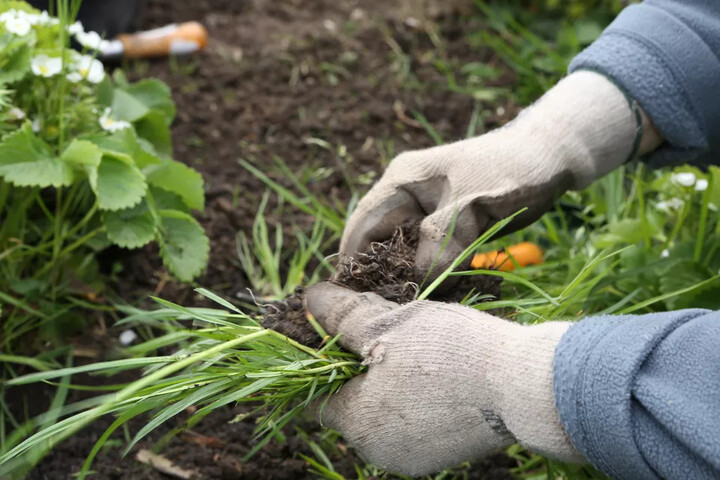Lush green grass growing in a lawn is undeniably lovely, but the same grass creeping into your flower beds can be one of the most stubborn weeds you encounter. In additional to perennial turf grasses that can escape lawns and invade gardens, there are several weedy annual and perennial grasses, such as crabgrass, that can be ongoing enemies for a gardener. Weed grasses require special attention to eradicate from the garden, especially so you don't harm nearby flowers or shrubs.

When to Kill Grass in Garden Beds
Most grasses spread by underground roots (rhizomes), as well as by dropping seeds. So efforts to eliminate grass in the garden become harder if you allow the plants to mature. Each plant can scatter hundreds of seeds in a garden bed. Thus, grass in the garden should be dealt with whenever you see it, ideally early in the growing season before seed heads appear.
Instructions
Using Broad-Spectrum Herbicide
One of the most effective methods to remove grass from flower beds is to use a broad-spectrum herbicide. But be aware that a broad-spectrum herbicide also will kill any ornamental plant it comes in contact with. Chemical herbicides are available as liquid concentrates that you mix with water and apply with a garden sprayer, as well as in premixed forms sold in spray bottles.
Don Protective Clothing
Don protective clothing, especially rubber gloves, before using a chemical herbicide. Choose a day with little wind and no rain in the forecast.
Apply Herbicide
Apply the herbicide to the entire exposed grass plant. A wand-style sprayer works best because you can target the grass with little to no overspray. If the grass is in close proximity to ornamental plants, you can block the spray with a piece of cardboard or shield them with an overturned bucket.
Observe Grass
Observe the grass over the next few days; it should begin to turn brown and die. If the blades are not completely dead, reapply herbicide. Avoid the temptation to dig up the grass too soon, as the herbicide must be transported down to the roots.
Dig Up Plant
Once the grass has appeared completely dead for several days, you can dig up the plant from your garden.
Using Selective Herbicide
If you need to kill grass growing close to ornamental plants, you can apply a grass-specific herbicide that targets only grasses without harming garden plants. These products will kill most annual grasses, such as crabgrass and foxtails, as well as perennial grasses, such as nimblewill and quackgrass. Apply selective herbicide exactly as you would a broad-spectrum herbicide.
However, if you have perennial nutsedge, also commonly called nutgrass, you'll need to apply a product specifically labeled to kill nutsedge and not just grasses in general. Nutsedge isn’t a grass but rather a member of the sedge family. You can identify nutsedge by the small tubers in the root ball.
Using Pre-Emergent Weed Killer
Pre-emergent herbicide does its work by preventing germination of new seeds that fall on the soil. These products do not affect the roots of perennial weeds, nor can they prevent existing weed seeds in the soil from germinating. Thus, they are of limited effect as a measure to prevent perennial grasses from growing in your garden.
Pre-emergents can be used along with other measures to help control grasses and weeds, but they will also prevent desirable seeds from germinating. If your garden contains ornamental plants that you want to self-seed, avoid this type of herbicide. Pre-emergent weed killers usually come in a granular form that is blended into the garden soil.
Applying Organic Methods
If you are uneasy about using garden chemicals, then consider one of these organic methods:
Vinegar: Diluted vinegar sprayed onto grass will kill it. However, it might require multiple applications.
Boiling water: Pouring boiling water over the grass can kill it, roots and all.
Flame: A variety of propane torch tools are available that allow you to kill weeds by hitting them with very high heat. This often (but not always) kills the roots, as well.
Solarization: If a large area of the garden is infiltrated by grass, you can kill the grass by laying clear plastic over the area and allowing sunlight to heat the soil beneath it. This will kill the seeds and roots of all plants in the soil beneath the plastic. It can be a good method if you are creating a garden bed in an area that contains lawn grass.
Corn gluten: This is an organic option that's normally applied to lawns to control crabgrass and other weeds. In theory, it can also work to hinder crabgrass in the garden, but it has no impact on turf grasses that have crept into garden beds.
Removing Grass by Hand
Small grass infestations in a garden can be addressed by hand removal. However, most grasses are perennial plants that can regrow if even a small bit of root remains. So complete removal involves carefully loosening the soil and tugging out as much of the roots as possible. With some grasses, the root system can be many inches long.
Hand removal is an ongoing process and can be done whenever you are performing routine weeding duties in the garden. It is not practical for large gardens that are heavily infested with grass. But for a small garden or one that has minor grass problems, this is an environmentally friendly solution.
Tips for Preventing Grass in Flower Beds
Once you've controlled a grass infestation, prevent it from coming back by covering the soil of the flower bed with a 3-inch layer of mulch to discourage new grass seeds from germinating. Landscape fabric is also an option, but it usually creates more work in the long run when it tears or when weeds germinate on top of the fabric. Instead, use wood chips, shredded leaves, or compost, all of which will prevent grass seeds from germinating and make weeding duties easier.